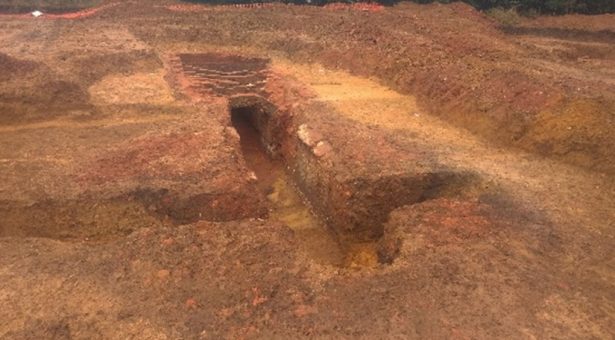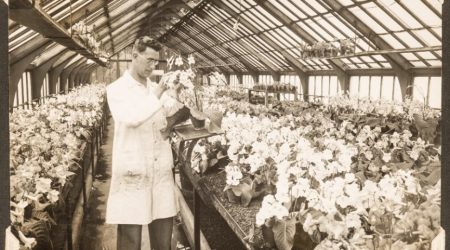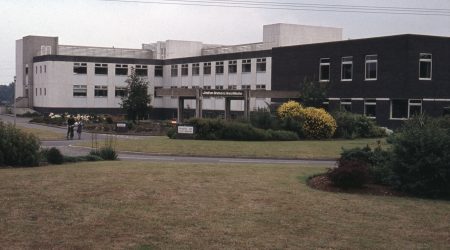Fruitful connections: Newfound Farm, Cringleford Heights and the John Innes legacy

For more than forty years, the John Innes Centre farmed the land at Newfound Farm, Cringleford, just along Colney Lane from the main laboratory buildings here in Norwich.
Emeritus Fellow, Professor Trevor Wang a member of Cringleford Parish Council has collated some interesting historic information about the site, and with fellow councillors has worked to shape the new development, ‘Cringleford Heights’ to include notable names on the roads, allotments and a heritage orchard.
Here, Trevor explains some of the history of the site, how John Innes names are appearing on the road maps and why heritage orchards have a place in Cringleford.
Pea Breeding in the 1970s
The Newfound Farm land was originally bought by the John Innes Foundation in 1976, and is now under development to become ‘Cringleford Heights’, providing 650 new homes.
The John Innes Institute, as it was called when it moved to Norwich in 1967, wanted to use Newfound Farm for pea breeding, but unfortunately this idea had to be abandoned when pea cyst nematode was discovered in the soil.
From then on, the land was contract farmed by Morley Research Station (now Morley Farms Ltd)) who still work on part of the site today.
A few years ago, the John Innes Foundation sold the farmland for development, and Church Farm, Bawburgh has become the John Innes Centre’s experimental trial site.
Road Naming and linking the past to the present
A few roads of houses are already occupied in Cringleford Heights, and the rest are under construction. A new roundabout has recently opened, and the housing development is rapidly taking shape with roads and homes appearing across the Newfound farmland.
In 2018, the local Parish Council took the initiative to request that the roads on the new housing development were named after notable past members of the John Innes Centre. This was agreed with the developers, our Trustees and South Norfolk Council, and a short list of names was compiled by Archivist, Sarah Wilmot.
The intention of this initiative was to connect the site with its recent past, so now when you pass the development on Colney Lane, you’ll notice Haldane Drive named after John Burdon Sanderson Haldane FRS (1892-1964), who was at the John Innes Institute from 1927 to 1937.
Other roads will be named after a wide range of notable staff from over 100 years of John Innes Centre history, including Caley, Bateson, Markham and Mather.
History of Newfound Farm
The name Newfound goes back to the 16th century when a ‘new-found’ band of clay was discovered there. At that time the land was owned by John Balleston who bought it from The Great Hospital. Because of its quality, much of the clay was exported to Holland as ‘Balleston Newfound’.
The clay was used locally for making pottery, brick and tiles for many years, probably into the 18th century when the site was turned over to farming.
Archaeological investigations undertaken as part of the current development of the site uncovered a old 16/17th century kiln close to a planned orchard and allotments. From the debris found with the kiln it is believed to be for the production of bricks and tiles.
Heritage Orchard
The John Innes Foundation Trustees and Cringleford Parish Council planted a heritage orchard of John Innes fruit tree varieties this winter on the site designated for an orchard.
The orchard will be home to 70 fruit trees including varieties of apple, pear and cherry, selected mainly from the fruit breeding programme when the John Innes Horticultural Institute was in Merton Park, South London.
The trees will link the orchard to the history of John Innes fruit breeding. The Institute continued apple breeding until 1975, and other fruit breeding continued over the next few years. The varieties developed during this programme continued to be released commercially until 1990. A few of these varieties are still available to this day.
The varieties selected for the orchard are associated with the work of Gavin Brown, Morley Crane, Dan Lewis and Peter Matthews.
All the trees have been grown to order for us by a specialist grower in Worcestershire who grafted bud material obtained from the National Collections at Brogdale in Kent onto suitable rootstocks.
Cringleford Parish Council aims to plant a second orchard on St Giles Park in a few years’ time. This second orchard will contain Norfolk fruit varieties, including cherry varieties launched after the John Innes Institute moved to Norwich.
The John Innes Centre has also recently planted a smaller heritage orchard at the Field Station, that will include some of the varieties used at Newfound, you can find out more about this orchard on the Church Farm webpages.
CAPTION – The entrance to a brick kiln uncovered prior to the start of building at Newfound Farm (image courtesy of Barratt/David Wilson)



